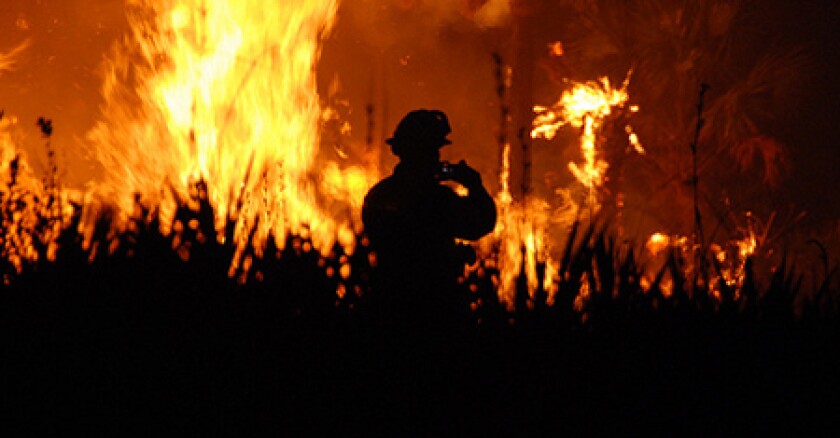The community’s five-year fuel reduction plan calls for $9.9 million worth of projects for the coming year. Measure L, the quarter-cent wildfire prevention sale tax on the June 7 ballot, was the county’s preferred answer to provide much of the money.
Measure L has 58% of the vote in initial returns, but needs a two-thirds majority of at least 66.66% to pass. That means year two of the wildfire protection plan will likely have to be funded without the tax, if it is funded.
Supervisors on Monday held budget hearings for the 2022-23 fiscal year that begins July 1. They seemed to favor giving at least $5.4 million in general fund money for fuel reduction, perhaps as a starting point.
“I wish we were doing more,” county Supervisor Diane Dillon said. “I wish we were doing the whole thing.”
County staff recommended giving $5.4 million, so the fuel reduction work can continue after July 1. Then the Board of Supervisors can revisit the issue in August, when several issues that could affect the overall county budget become clearer.
Supervisor Alfredo Pedroza said the county can’t walk away from its commitment to keep the community safe, even though Measure L looks likely to lose. But the county must take the wildfire prevention money from other possible projects.
“The $5.4 million is coming at a cost ... What are we not doing?” he said.
Deputy County Executive Officer Helene Franchi said the county will take the money from roads and facility capital projects. But Franchi didn’t have a definitive list. She will work with the Public Works Department to see which projects are the highest priorities and which could be delayed.
Still another possibility is $32.5 million in hazard mitigation grants the county is seeking and that are in various stages of review from the state Office of Emergency Services. But Franchi didn't expect an answer on this front in the near term.
“There are no guarantees,” Franchi said. “It’s highly competitive.”
County supervisors are working on a $600 million budget. Much of that money must be spent in predetermined ways according to state and federal rules, with the $250 million general fund portion providing the most discretion.
The county budget pays for services ranging from wildfire prevention to libraries, to the justice system, to health and social services, to rural planning and environmental services to rural road repairs.
Budget hearings provide residents with a chance to speak out on their priorities. Several from Diamond Mountain near Calistoga came to plead for road repairs.
Narrow Diamond Mountain Road winds up into the Mayacamas Mountains. Residents said it needs immediate repair and is in such bad condition it could hinder wildfire evacuations and response.
“It’s a dangerous road,” one said, adding he has slid on it while driving because the pavement is broken.
Public Works Director Steven Lederer explained how the state tax for road maintenance had no inflation adjustment from 1993 to 2018. That led to a backlog of more than $100 million in Napa County road maintenance.
“You don’t dig out of a 20-year deferred maintenance hole overnight,” Lederer said. “It would be great if everybody could be first.”
Diamond Mountain Road is scheduled for repairs, but various factors could delay projects there until next spring. Among them is a supply chain holdup for steel beams needed for a retaining wall, he said.
Napa County’s recommended budget comes in a 400-plus-page book. Assistant County Executive Officer Becky Craig said the county has recovered from the pandemic recession and is in revenue growth mode — but inflation and another possible recession are factors.
“While we are optimistic at this point, it is definitely cautious because we don’t believe it will continue on indefinitely,” Craig said.
County Executive Officer Minh Tran, in a budget preface, wrote about the fiscal dynamics the county faces.
“The county has recovered well from the COVID-19 pandemic,” he wrote. “Revenues are up and visitors have returned.”
However, the county faces significant challenges, including managing the drought, housing needs, fire preparedness, workforce availability and rapidly increasing costs, he said.
Inflation is increasing county revenues from property, hotel and sales taxes. But it is also increasing county costs, such as for fuel and for food at the county jail, Tran wrote.
“Much of the county workforce commutes to Napa County, given the high price and limited inventory of housing,” Tran said. “With higher commuting costs, we may struggle to attract and retain our workforce in the coming years, since fuel costs erode employee’s real wages.”
Supervisors will continue budget hearings on Tuesday as they consider various special districts. The meeting begins at 9 a.m. at the county administration building, 1195 Third St. in downtown Napa.
They are to take final votes on the 2022-23 budget on June 21.
©2022 Napa Valley Register, Calif. Distributed by Tribune Content Agency, LLC.








